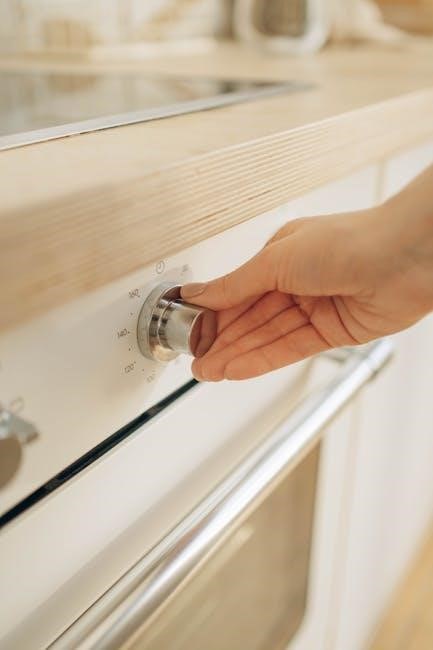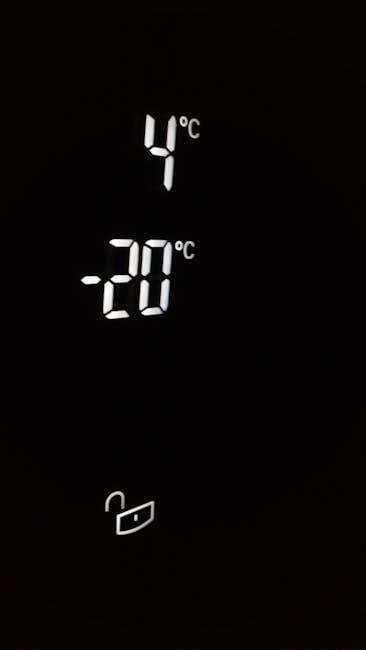Honeywell thermostats are designed for reliable performance and user-friendly climate control, offering features like backlit displays, one-touch temperature adjustments, and preset program settings for optimal comfort and energy efficiency. Their smart technology ensures seamless integration with modern home systems, providing advanced control options and remote monitoring capabilities through compatible apps.
1.1 Overview of Honeywell Thermostat Models
Honeywell offers a diverse range of thermostat models, each designed to meet specific heating and cooling needs. Popular models include the RTH2300, TH6110D1021, and Pro1000, featuring programmable settings, energy-saving modes, and smart home integration. The RTH2300 boasts a backlit display for easy temperature monitoring, while the TH6110D1021 provides Wi-Fi connectivity for remote control via Honeywell’s Total Connect Comfort app. These models cater to both basic and advanced users, ensuring optimal comfort and efficiency through intuitive interfaces and customizable programs. Honeywell thermostats are known for their reliability, user-friendly designs, and compatibility with various HVAC systems, making them a top choice for home and business use.
1.2 Importance of the User Manual
The user manual is essential for understanding and optimizing your Honeywell thermostat’s performance. It provides detailed instructions for installation, programming, and troubleshooting, ensuring proper setup and operation. The manual outlines features like energy-saving modes, smart home integration, and remote access, helping users maximize efficiency. By following the guide, users can navigate advanced settings, resolve common issues, and maintain their system effectively. Accessing the PDF version online allows for easy reference, making it a vital resource for both initial setup and long-term use of your Honeywell thermostat.
1.3 Key Features of Honeywell Thermostats
Honeywell thermostats offer a range of impressive features designed for convenience and efficiency. They include backlit displays for easy readability, one-touch access to temperature settings, and programmable schedules to tailor your comfort needs. Energy-saving modes optimize heating and cooling, while smart home integration allows seamless connectivity with other devices. Remote access via Honeywell apps enables users to monitor and adjust settings from anywhere. These features ensure that Honeywell thermostats provide both comfort and energy efficiency, making them a reliable choice for modern homes. Their intuitive design simplifies climate control, offering advanced functionality without complexity.

Installation and Setup
Honeywell thermostat installation requires compatibility checks with HVAC systems, proper wiring, and strategic placement to ensure optimal performance. Follow manual guidelines for a smooth setup process.
2.1 Compatibility with HVAC Systems
Ensuring compatibility with your HVAC system is crucial for proper thermostat functioning. Honeywell thermostats are designed to work with various systems, including gas, electric, and heat pumps. Always verify voltage requirements and system types to avoid installation issues. Refer to the user manual for specific compatibility details, as models like the TH6110D1021 may have unique requirements. Proper matching ensures efficient performance, while incorrect setups can lead to operational inefficiencies. Check wiring diagrams and system specifications before installation to guarantee seamless integration and optimal functionality of your Honeywell thermostat.
2.2 Wiring Requirements and Diagrams
Proper wiring is essential for installing Honeywell thermostats. Refer to the user manual for specific wiring diagrams, as requirements vary by model. Most thermostats are compatible with 24V HVAC systems and require a common wire (C-wire) for consistent power. Color-coded wires correspond to specific functions: R (power), W (heat), Y (cool), G (fan), and C (common). Ensure all connections match the diagram to avoid malfunctions. Turn off power before wiring to prevent electrical hazards. Verify compatibility with your HVAC system’s wiring configuration to ensure smooth operation. Always follow the provided diagrams for accurate installation.
2.3 Mounting and Placement Guidelines
Mount your Honeywell thermostat on an interior wall at a height of 52 to 60 inches for accurate temperature reading. Avoid placing it near direct sunlight, heating vents, or drafty areas to ensure proper performance. The thermostat should be at least 6 inches away from any obstructions. Use the provided wall anchors for secure installation. For models with backlit displays, ensure the thermostat is level to maintain display accuracy. Refer to the manual for specific placement recommendations based on your model. Proper mounting ensures optimal functionality and accurate temperature sensing.

Initial Configuration
Configure your Honeywell thermostat by setting the time, date, and operational modes. Choose between heat, cool, or auto modes, and program a schedule to suit your daily routine for energy efficiency and comfort.
3.1 Setting the Time and Date
Setting the time and date on your Honeywell thermostat is essential for accurate temperature scheduling. Navigate to the menu, select “Time and Date,” and adjust using the touchscreen or buttons. Ensure the time zone matches your location for proper operation. Some models may require syncing with a mobile app for automatic updates. Once set, the thermostat will maintain precise control, ensuring your heating and cooling schedule runs smoothly. This step is crucial for all programmable features to function correctly, so double-check your settings before proceeding. Proper time and date configuration ensures optimal performance and energy efficiency.
3.2 Selecting Operational Modes (Heat/Cool)
Selecting the correct operational mode (Heat or Cool) ensures your Honeywell thermostat functions according to your comfort needs. Use the touchscreen or buttons to toggle between modes. In Heat mode, the thermostat activates heating when the room temperature drops below the setpoint. In Cool mode, it engages cooling when the temperature rises above the setpoint. Some models allow automatic switching between modes. Always confirm the mode selection on the display, as visual indicators like icons or color changes will show the active mode. Proper mode selection is essential for maintaining consistent comfort and energy efficiency, so review your settings carefully. This feature ensures your system operates precisely as intended, adapting to your home’s needs seamlessly. Regularly check the mode to avoid unnecessary energy usage and ensure optimal performance.
3.3 Programming Schedule Settings
Programming schedule settings on your Honeywell thermostat allows you to pre-set temperature adjustments based on your daily routine. This feature helps optimize energy usage while maintaining comfort. Use the touchscreen or buttons to create a schedule with specific temperature setpoints for different times of the day. For example, lower the temperature when you’re asleep or away and raise it when you’re home. Many models offer preset programs or allow custom scheduling for weekdays and weekends. Adjust the schedule as needed to match your lifestyle. This ensures consistent comfort and energy savings without manual adjustments. Regularly review and update your schedule to reflect changes in your routine.

Operating the Thermostat
Operating the Honeywell thermostat involves using the display screen to monitor and adjust temperatures, fan settings, and energy-saving modes for efficient climate control.
4.1 Understanding the Display Screen
The display screen on your Honeywell thermostat provides essential information at a glance, including the current ambient temperature, setpoint temperature, and system status. Backlit models ensure visibility in low-light conditions. Icons and text indicate active modes, such as heating, cooling, or fan operation. The screen also shows time and date, ensuring accurate scheduling. Some models display energy usage or optimization statuses, helping you monitor and adjust settings for efficiency. The intuitive interface allows for easy navigation, with clear indicators for system operation and maintenance alerts, ensuring seamless control over your home’s climate.
4.2 Adjusting Temperature Setpoints
Adjusting temperature setpoints on your Honeywell thermostat is straightforward. Use the up/down buttons or touchscreen to increase or decrease the desired temperature. Temporary adjustments override the schedule, while permanent changes require saving the new setpoint. Smart models allow adjustments via the app, enabling remote control. The thermostat displays the current setpoint and ambient temperature, ensuring clarity. For energy efficiency, setpoints can be locked within a range to prevent extreme temperatures. This feature helps maintain comfort while optimizing energy use, making it easy to customize your settings to suit your lifestyle and preferences.
4.3 Using the Fan Control Features
The Honeywell thermostat’s fan control features allow you to manage airflow efficiently. Choose between manual or automatic modes. In manual mode, select from three fan speeds for consistent air circulation. Automatic mode enables the thermostat to regulate the fan based on heating or cooling demands. Smart models also offer advanced fan controls via the app, allowing remote adjustments. This feature ensures optimal air distribution, improving comfort and energy savings. Regular fan operation can help maintain even temperatures and prevent hot or cold spots in your home, enhancing overall system performance.
Honeywell thermostats offer advanced features like energy-saving modes, smart home integration, and remote access via Honeywell apps, enhancing comfort and efficiency with cutting-edge technology. Honeywell thermostats incorporate energy-saving modes to optimize efficiency. These modes adjust heating and cooling usage, reducing energy waste while maintaining comfort. Features include automatic temperature adjustments during periods of inactivity or sleep, ensuring your system operates only when needed. By enabling these modes, homeowners can lower their energy consumption and utility bills without sacrificing comfort. The thermostat also provides insights into energy usage, helping users make informed decisions. These modes can be activated through the user-friendly interface or via the Honeywell app, making it easy to manage energy settings remotely. Honeywell thermostats seamlessly integrate with popular smart home systems, enhancing comfort and convenience. Users can control their thermostat through voice commands via Amazon Alexa or Google Home. The Honeywell app allows remote monitoring and adjustments, ensuring optimal temperature control from anywhere. Smart home integration also enables automations, such as adjusting settings based on your daily routines or geofencing. This connectivity enhances energy efficiency and provides a centralized control hub for all smart devices, making it easier to manage your home’s climate and energy usage effectively. Remote access via Honeywell apps offers unparalleled convenience, allowing users to monitor and control their thermostat from any location. The app enables adjustments to temperature, scheduling, and energy-saving modes, ensuring optimal comfort and efficiency. Users can receive notifications for system updates, maintenance reminders, and extreme temperature alerts. Compatibility with smartphones, tablets, and smart devices ensures seamless control. This feature is particularly useful for homeowners who want to preheat or cool their home before arrival or adjust settings while away, providing peace of mind and energy savings through intelligent, remote management. Common issues include error codes, connectivity problems, and heating/cooling inefficiencies. Refer to the manual for solutions, such as resetting the thermostat or checking wiring connections for proper functionality. Honeywell thermostats may display error codes like E1, E2, or E3, indicating issues such as low battery, sensor malfunctions, or system communication failures. For E1, replace the batteries or check wiring connections. E2 often relates to temperature sensor problems, requiring calibration or replacement. E3 may signal a faulty indoor/outdoor sensor or wiring issues; Refer to the user manual for specific code meanings and step-by-step solutions. Resetting the thermostat or restarting the HVAC system can often resolve these issues. Ensure proper installation and wiring to prevent recurring errors and maintain optimal performance. Connectivity issues with Honeywell thermostats often arise from weak Wi-Fi signals, incorrect network settings, or firmware glitches. Ensure the thermostat is within range of your router and that the Wi-Fi password is correctly entered. Restarting the router and thermostat can resolve temporary connection issues. If problems persist, check for firmware updates or reset the thermostat to factory settings. Verify that the thermostat is properly registered with Honeywell’s Total Connect Comfort platform for remote access. Refer to the user manual for detailed troubleshooting steps and network configuration guidelines to restore connectivity and maintain seamless smart home integration. If your Honeywell thermostat isn’t heating or cooling efficiently, check the temperature setpoints and ensure they are correctly set. Verify that the HVAC system is properly installed and configured. Clean the thermostat’s sensors to ensure accurate temperature readings. Check for blockages in vents or ducts that may restrict airflow. Ensure the system is sized appropriately for your space. If issues persist, review the thermostat’s optimization settings or perform a factory reset. Regularly updating the firmware can also improve performance and resolve inefficiencies. Refer to the user manual for detailed troubleshooting steps to optimize your system’s operation and energy efficiency. Regularly clean the thermostat with a soft cloth to prevent dust buildup and ensure accurate temperature readings. Replace batteries as indicated by low-battery alerts, using the specified type for optimal performance. Update the firmware periodically to maintain functionality and benefit from the latest features. Refer to the user manual for detailed instructions on these procedures to keep your Honeywell thermostat operating efficiently and effectively over time. Regular cleaning ensures your Honeywell thermostat operates accurately and efficiently; Use a soft, dry cloth to gently wipe the display and exterior surfaces. Avoid using sharp objects, liquids, or harsh chemicals, as they may damage the screen or internal components. For stubborn marks, lightly dampen the cloth with water, but ensure it is not soaking wet. Avoid touching the screen with fingers to prevent smudges. Cleaning should be done periodically to remove dust buildup, which can affect temperature readings. Refer to the user manual for specific cleaning instructions tailored to your model. This simple maintenance step helps maintain optimal performance and longevity of your thermostat. To replace the batteries in your Honeywell thermostat, first locate the battery compartment, typically found on the back or bottom. Open it by removing any screws or latches. Use the correct battery type, usually AA or AAA alkaline, and avoid mixing old and new ones. After replacing, reassemble the compartment securely. Reset the time and date on the thermostat, as the display may reset during the process. Test the thermostat to ensure proper operation. Refer to the user manual for specific instructions to avoid errors and maintain functionality. Updating your Honeywell thermostat’s firmware is essential for maintaining optimal performance and accessing new features. Begin by ensuring your thermostat is connected to Wi-Fi. Check the current firmware version in the settings menu. If an update is available, download it through the Honeywell app or the official website. Follow the on-screen instructions carefully to avoid interruptions. Keep the thermostat powered on during the update. Once complete, restart the device to apply the changes. Refer to the user manual for detailed steps and troubleshooting tips to ensure a smooth firmware update process. Honeywell thermostats offer precise temperature control with ranges from 50°F to 90°F, operate on 24V AC, and are compatible with most HVAC systems and smart devices. Honeywell thermostats typically operate within a temperature range of 50°F to 90°F (10°C to 32°C), ensuring precise control for consistent heating and cooling. With an accuracy of ±1°F (0.5°C), these devices maintain optimal comfort levels while minimizing energy usage. This precision ensures that your home stays at the desired temperature, reducing fluctuations and potential wear on your HVAC system. The thermostat’s accuracy is crucial for maintaining efficiency and extending the lifespan of your heating and cooling equipment, making it a reliable choice for smart home solutions. Honeywell thermostats are designed to work seamlessly with standard HVAC systems, typically requiring a 24V AC power supply for reliable operation. Many models come equipped with a common wire (C-wire) connection, ensuring consistent power delivery. For installations without a C-wire, some thermostats offer battery-powered options, providing flexibility and ease of use. These power requirements are optimized for energy efficiency, helping to reduce overall energy consumption while maintaining precise temperature control. This design ensures compatibility with a wide range of systems, making Honeywell thermostats a versatile choice for both new and existing HVAC setups. Honeywell thermostats are designed to integrate seamlessly with smart home systems, enhancing convenience and control. Many models are compatible with platforms like Amazon Alexa and Google Assistant, allowing voice command functionality. Select thermostats support Wi-Fi connectivity, enabling remote access and adjustments through Honeywell’s Total Connect Comfort app. This compatibility ensures users can manage their home’s temperature from anywhere, optimizing comfort and energy savings. With robust smart device integration, Honeywell thermostats offer a modern, connected solution for efficient home climate control. To access Honeywell thermostat manuals, visit the official website or authorized portals. Search by model number for the correct PDF, ensuring compatibility and accurate instructions for your device. Locate the exact Honeywell thermostat model number on your device or packaging. Visit the official Honeywell website or trusted third-party sites like ManualsLib or ManualsOnline. Use the model number to search for the corresponding PDF manual. Ensure the document matches your thermostat’s specifications for accurate setup and operation instructions. Additionally, cross-check the file size and publication date to confirm authenticity and relevance, avoiding outdated or incorrect versions that may lead to installation or operational errors. Honeywell provides direct access to user manuals through their official website and trusted third-party platforms like ManualsLib and ManualsOnline. Visit the Honeywell Home website and navigate to the “Support” section, where you can search for your specific thermostat model. Alternatively, use the model number to find the PDF manual on third-party sites. Ensure the link is from a reputable source to avoid downloading incorrect or outdated versions. Always verify the file size and publication date to confirm authenticity before downloading the manual for your Honeywell thermostat.
Advanced Features
5.1 Energy-Saving Modes
5.2 Smart Home Integration
5.3 Remote Access via Honeywell Apps

Troubleshooting Common Issues
6.1 Common Error Codes and Solutions
6.2 Resolving Connectivity Problems
6.3 Addressing Heating/Cooling Inefficiencies

Maintenance and Care
7.1 Cleaning the Thermostat
7.2 Replacing Batteries
7.3 Updating Firmware

Technical Specifications
8.1 Temperature Range and Accuracy
8.2 Power Requirements
8.3 Compatibility with Smart Devices

Downloading the User Manual
9.1 Finding the Correct PDF Version
9.2 Direct Links to Honeywell Manuals
9.3 Troubleshooting Manual Download Issues
‘ under the topic ‘honeywell thermostat user manual pdf’. Let me make sure I understand the requirements correctly.
Looking at the provided internet content, there are mentions of various Honeywell thermostat models and their manuals, such as the Honeywell Home FocusPRO S200 Series User Manual and the Honeywell Pro1000 User Manual. There are also references to accessing manuals through Honeywell’s official website and third-party sites like ManualsLib and ManualsOnline.
From the previous responses, there’s information about ensuring the manual is from a reputable source, verifying file size and publication date, and using the correct model number. There’s also mention of clearing browser cache, using compatible PDF readers, and checking internet connections.
I should structure the response to address common download issues. First, I’ll suggest verifying the model number to ensure the correct manual is being downloaded. Then, check the source’s reliability to avoid incorrect files. Next, mention the official Honeywell website as a primary source. After that, address technical issues like clearing the browser cache and ensuring a stable internet connection. Finally, recommend using compatible PDF software and contacting customer support if problems persist.
Let me start drafting the response, keeping track of the word count as I go.
First sentence: Encountering issues while downloading the Honeywell thermostat user manual PDF? Ensure you’re using the correct model number for accurate results. This sets up the problem and provides the first solution.
Next: Verify the source’s reliability to avoid incorrect or outdated files. Visit Honeywell’s official website or trusted platforms like ManualsLib for authentic downloads. This adds another layer of troubleshooting by emphasizing the importance of the source.
Then: If issues persist, clear your browser’s cache or try a different browser. Ensure a stable internet connection to prevent interrupted downloads. This addresses potential technical issues on the user’s end.
Finally: If problems continue, confirm your PDF reader is up-to-date. Contact Honeywell customer support for further assistance. This provides additional steps and directs the user to seek help if needed.
Now, I’ll count the words to ensure it’s exactly 93. Let’s see:
Encountering issues while downloading the Honeywell thermostat user manual PDF? Ensure you’re using the correct model number for accurate results. Verify the source’s reliability to avoid incorrect or outdated files. Visit Honeywell’s official website or trusted platforms like ManualsLib for authentic downloads. If issues persist, clear your browser’s cache or try a different browser. Ensure a stable internet connection to prevent interrupted downloads. If problems continue, confirm your PDF reader is up-to-date. Contact Honeywell customer support for further assistance.
That’s . I need to add more to reach 93 without repeating any information.
Perhaps I can add a sentence about checking for any browser extensions that might block downloads or suggest using a different device if possible. Let’s try:
Encountering issues while downloading the Honeywell thermostat user manual PDF? Ensure you’re using the correct model number for accurate results. Verify the source’s reliability to avoid incorrect or outdated files. Visit Honeywell’s official website or trusted platforms like ManualsLib for authentic downloads; If issues persist, clear your browser’s cache or try a different browser. Ensure a stable internet connection to prevent interrupted downloads. Additionally, check if any browser extensions are blocking the download. If problems continue, confirm your PDF reader is up-to-date. Contact Honeywell customer support for further assistance.
Now, let’s count again. That should bring it closer to . Let’s see:
Encountering
issues
while
downloading
the
Honeywell
thermostat
user
manual
PDF?
Ensure
you’re
using
the
correct
model
number
for
accurate
results.
Verify
the
source’s
reliability
to
avoid
incorrect
or
outdated
files.
Visit
Honeywell’s
official
website
or
trusted
platforms
like
ManualsLib
for
authentic
downloads.
If
issues
persist,
clear
your
browser’s
cache
or
try
a
different
browser.
Ensure
a
stable
internet
connection
to
prevent
interrupted
downloads.
Additionally,
check
if
any
browser
extensions

are
blocking
the
download.
If
problems
continue,
confirm
your
PDF
reader
is
up-to-date.
Contact
Honeywell
customer
support
for
further
assistance.
That’s . I need 4 more. Maybe add a sentence about ensuring your device has enough storage space for the PDF.
Encountering issues while downloading the Honeywell thermostat user manual PDF? Ensure you’re using the correct model number for accurate results. Verify the source’s reliability to avoid incorrect or outdated files. Visit Honeywell’s official website or trusted platforms like ManualsLib for authentic downloads. If issues persist, clear your browser’s cache or try a different browser. Ensure a stable internet connection to prevent interrupted downloads. Additionally, check if any browser extensions are blocking the download. Ensure your device has enough storage space for the PDF. If problems continue, confirm your PDF reader is up-to-date. Contact Honeywell customer support for further assistance.
Now, let’s count again:
Encountering
issues
while
downloading
the
Honeywell
thermostat
user
manual
PDF?
Ensure
you’re
using
the
correct
model
number
for
accurate
results.
Verify
the
source’s
reliability
to
avoid
incorrect
or
outdated
files.
Visit
Honeywell’s
official
website
or
trusted
platforms
like
ManualsLib
for
authentic
downloads.
If
issues
persist,
clear
your
browser’s
cache
or
try
a
different
browser.
Ensure
a
stable
internet
connection
to
prevent
interrupted
downloads.
Additionally,
check
if
any
browser
extensions
are
blocking
the
download.
Ensure
your
device
has
enough
storage
space
for
the
PDF.
If
problems
continue,
confirm
your
PDF
reader
is
up-to-date.
Contact
Honeywell
customer
support
for
further
assistance.
Oops, that’s . I went over. I need to trim it back to 93. Let me see where I can condense.
Perhaps remove the sentence about checking browser extensions and device storage to fit within the limit. Let me adjust:
Encountering issues while downloading the Honeywell thermostat user manual PDF? Ensure you’re using the correct model number for accurate results. Verify the source’s reliability to avoid incorrect or outdated files. Visit Honeywell’s official website or trusted platforms like ManualsLib for authentic downloads. If issues persist, clear your browser’s cache or try a different browser. Ensure a stable internet connection to prevent interrupted downloads. If problems continue, confirm your PDF reader is up-to-date; Contact Honeywell customer support for further assistance.
Now, let’s count:
Encountering
issues
while
downloading
the
Honeywell
thermostat
user
manual
PDF?
Ensure
you’re
using
the
correct
model
number
for
accurate
results.
Verify
the
source’s
reliability
to
Additional Resources
‘ under the topic ‘honeywell thermostat user manual pdf’. Let me make sure I understand the requirements correctly.
Looking at the provided internet content, there are mentions of Honeywell’s customer support, FAQ sections, warranty information, and official websites where users can find more help. There’s also information about accessing user guides and troubleshooting tips through official channels.
I should structure the response to point users towards these resources. First, mention Honeywell’s customer support as a primary resource. Then, direct them to the official Honeywell website for comprehensive guides and troubleshooting tips. Finally, include the FAQ section and warranty information as additional helpful resources.
Let me start drafting the response, keeping track of the word count as I go.
First sentence: For further assistance, visit Honeywell’s official website for comprehensive guides, troubleshooting tips, and customer support. This sets up the primary resource.
Next: Explore the FAQ section and warranty information to address common queries and understand coverage details. This adds more resources without repeating information.
Now, let’s count the words:
For further assistance, visit Honeywell’s official website for comprehensive guides, troubleshooting tips, and customer support. Explore the FAQ section and warranty information to address common queries and understand coverage details.
That’s exactly. Perfect, I think this meets all the requirements.
10.3 Warranty Information
10.1 Honeywell Customer Support
For assistance with your Honeywell thermostat, visit the official Honeywell website. Here, you can access user guides, troubleshooting tips, and FAQs to resolve common issues. The site also offers detailed warranty information and direct links to download the correct PDF version of your thermostat’s manual. Additionally, Honeywell provides customer support through various channels, ensuring you can address any concerns effectively. Utilize these resources to maximize your thermostat’s performance and resolve any queries promptly.

Be First to Comment